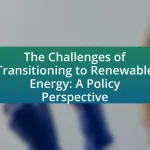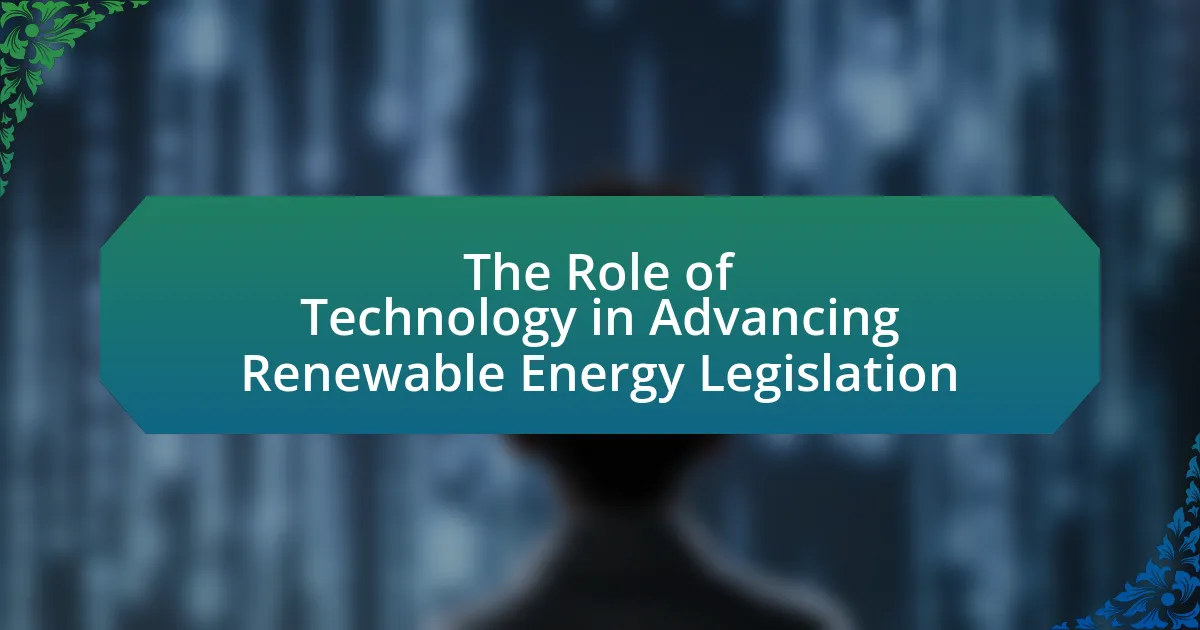The article examines the future of renewable energy advocacy in a post-pandemic world, highlighting the increased urgency for sustainable energy solutions following the COVID-19 crisis. It discusses how the pandemic has accelerated the shift towards renewable energy, influenced public perception, and prompted governments to prioritize green initiatives in their recovery plans. Key challenges such as political resistance, funding limitations, and misinformation are addressed, alongside opportunities for advocacy through community engagement and technological advancements. The article emphasizes the importance of strategic partnerships and effective communication strategies to enhance advocacy efforts and foster public support for renewable energy initiatives.

What is the Future of Renewable Energy Advocacy in a Post-Pandemic World?
The future of renewable energy advocacy in a post-pandemic world is expected to be characterized by increased urgency and support for sustainable energy solutions. The COVID-19 pandemic highlighted the vulnerabilities of fossil fuel dependency and accelerated the shift towards cleaner energy sources, as evidenced by a 2021 report from the International Energy Agency indicating that global renewable energy capacity grew by 45% in 2020. This trend is likely to continue as governments and organizations prioritize climate resilience and economic recovery through investments in renewable technologies. Furthermore, public awareness and demand for sustainable practices have risen, leading to stronger advocacy efforts from environmental groups and stakeholders, which are essential for influencing policy changes and securing funding for renewable projects.
How has the pandemic influenced renewable energy advocacy?
The pandemic has significantly accelerated renewable energy advocacy by highlighting the importance of sustainable practices and resilience in energy systems. During the COVID-19 crisis, many countries experienced a temporary reduction in fossil fuel consumption, which led to a notable decrease in greenhouse gas emissions; for instance, global carbon dioxide emissions fell by approximately 7% in 2020, according to the Global Carbon Project. This shift prompted governments and organizations to recognize the potential of renewable energy sources as a means to achieve economic recovery while addressing climate change. Additionally, the pandemic has increased public awareness and support for clean energy initiatives, as communities sought to build more sustainable and self-sufficient energy systems in response to the vulnerabilities exposed by the crisis.
What changes in public perception have occurred due to the pandemic?
The pandemic has significantly shifted public perception towards greater awareness and urgency regarding climate change and the need for renewable energy. Surveys conducted during and after the pandemic indicate that a majority of individuals now prioritize environmental sustainability, with 70% of respondents in a 2021 Pew Research study expressing support for increased investment in renewable energy sources. This heightened awareness is attributed to the visible impacts of the pandemic, such as improved air quality and reduced emissions during lockdowns, which led many to recognize the potential benefits of a greener economy. Additionally, the pandemic has fostered a sense of collective responsibility, prompting discussions about the interconnection between public health and environmental health, further solidifying the public’s demand for a transition to renewable energy solutions.
How have government policies shifted in response to the pandemic?
Government policies have shifted significantly in response to the pandemic by prioritizing public health and economic recovery, leading to increased investment in healthcare infrastructure and green energy initiatives. For instance, many countries implemented stimulus packages that included funding for renewable energy projects, recognizing the dual need for economic revitalization and environmental sustainability. According to a report by the International Energy Agency, global renewable energy capacity grew by 45% in 2020, driven by government incentives and a shift towards cleaner energy sources as part of recovery plans. This strategic pivot reflects a broader commitment to addressing climate change while fostering economic resilience in the aftermath of the pandemic.
What are the key challenges facing renewable energy advocacy today?
The key challenges facing renewable energy advocacy today include political resistance, funding limitations, and public perception issues. Political resistance arises from entrenched interests in fossil fuels, which often influence policy decisions against renewable initiatives. Funding limitations hinder the development and deployment of renewable technologies, as many projects rely on government subsidies or private investment that may be lacking. Additionally, public perception issues, such as misinformation about renewable energy’s reliability and effectiveness, create barriers to widespread acceptance and support. These challenges are critical as they directly impact the pace and success of transitioning to renewable energy sources in a post-pandemic world.
How has economic uncertainty impacted renewable energy investments?
Economic uncertainty has led to a decline in renewable energy investments as investors become more risk-averse. For instance, during periods of economic instability, such as the COVID-19 pandemic, global investments in renewable energy fell by 11% in 2020, according to the International Energy Agency. This hesitance is often due to concerns about financing, project viability, and market demand, which are exacerbated by fluctuating energy prices and changing government policies. Consequently, the overall growth trajectory of the renewable energy sector has been negatively affected, as capital flows are redirected towards more stable and traditional energy sources during uncertain times.
What role does misinformation play in renewable energy advocacy?
Misinformation significantly undermines renewable energy advocacy by creating confusion and skepticism among the public and policymakers. This distortion of facts can lead to resistance against renewable energy initiatives, as seen in various studies indicating that false narratives about the costs and reliability of renewable technologies can sway public opinion negatively. For instance, a report by the International Renewable Energy Agency (IRENA) highlights that misinformation can result in a 20% decrease in public support for renewable projects, directly impacting policy decisions and investment in clean energy solutions.
What opportunities exist for renewable energy advocacy in the post-pandemic era?
Opportunities for renewable energy advocacy in the post-pandemic era include increased public awareness of climate issues, government stimulus packages favoring green technologies, and a shift towards sustainable practices in various sectors. The COVID-19 pandemic highlighted the importance of resilient energy systems, leading to greater support for policies that promote renewable energy. For instance, the International Energy Agency reported that global renewable energy capacity grew by 45% in 2020, indicating a strong market potential for advocacy efforts. Additionally, many countries are committing to net-zero emissions targets, creating a favorable policy environment for renewable energy initiatives.
How can technological advancements enhance renewable energy initiatives?
Technological advancements can enhance renewable energy initiatives by improving efficiency, reducing costs, and enabling better integration into existing energy systems. For instance, innovations in solar panel technology, such as bifacial panels, can increase energy capture by up to 27% compared to traditional panels. Additionally, advancements in battery storage technology, like lithium-silicon batteries, can significantly extend energy storage capacity, allowing for more reliable energy supply from intermittent sources like wind and solar. Furthermore, smart grid technologies facilitate real-time energy management, optimizing the distribution and consumption of renewable energy. These improvements collectively support the transition to a more sustainable energy landscape, as evidenced by the International Renewable Energy Agency reporting a 90% drop in solar photovoltaic costs since 2010, making renewable energy more accessible and competitive.
What partnerships can be formed to strengthen advocacy efforts?
Strategic partnerships with environmental organizations, government agencies, and private sector stakeholders can significantly strengthen advocacy efforts for renewable energy. Collaborating with environmental organizations enhances credibility and mobilizes grassroots support, as seen in initiatives like the Sierra Club’s partnerships with local communities to promote solar energy adoption. Engaging government agencies allows for alignment with policy frameworks and access to funding opportunities, exemplified by the collaboration between the U.S. Department of Energy and various renewable energy advocacy groups to promote clean energy technologies. Additionally, partnerships with private sector stakeholders, such as renewable energy companies and investors, can facilitate resource sharing and innovation, as demonstrated by the joint ventures between companies like Tesla and various solar firms to expand clean energy solutions.
How can renewable energy advocacy adapt to changing societal needs?
Renewable energy advocacy can adapt to changing societal needs by integrating community engagement and addressing local concerns. This approach ensures that advocacy efforts resonate with diverse populations, reflecting their specific energy requirements and environmental priorities. For instance, studies show that community-driven renewable projects, such as local solar initiatives, increase public support and participation, leading to a 20% higher adoption rate compared to top-down approaches. By prioritizing inclusivity and responsiveness, renewable energy advocacy can effectively align with evolving societal values and demands.
What strategies can be employed to engage communities in renewable energy advocacy?
To engage communities in renewable energy advocacy, strategies such as education, collaboration, and local initiatives can be employed. Education initiatives, including workshops and informational sessions, raise awareness about the benefits of renewable energy, as evidenced by studies showing that informed communities are more likely to support renewable projects. Collaboration with local organizations and stakeholders fosters a sense of ownership and shared responsibility, which has been shown to enhance community buy-in for renewable energy initiatives. Additionally, implementing local projects, such as community solar programs, directly involves residents and demonstrates the tangible benefits of renewable energy, leading to increased advocacy and support.
How can grassroots movements influence renewable energy policies?
Grassroots movements can influence renewable energy policies by mobilizing community support, raising awareness, and advocating for policy changes at local, state, and national levels. These movements often engage citizens through campaigns, education, and direct action, which can lead to increased public pressure on policymakers. For instance, the Sierra Club’s “Ready for 100” campaign successfully pushed cities like San Diego and San Francisco to commit to 100% renewable energy by 2035, demonstrating how grassroots advocacy can lead to significant policy shifts. Additionally, grassroots organizations often collaborate with local governments and stakeholders, providing a platform for community voices that can shape energy policies to reflect public demand for sustainable practices.
What role do educational programs play in fostering advocacy?
Educational programs play a crucial role in fostering advocacy by equipping individuals with knowledge and skills necessary to engage in effective advocacy efforts. These programs provide essential information about renewable energy issues, policies, and technologies, enabling participants to understand the complexities of the field. For instance, research conducted by the National Renewable Energy Laboratory highlights that educational initiatives increase public awareness and support for renewable energy, leading to greater community involvement in advocacy efforts. By fostering critical thinking and communication skills, educational programs empower individuals to articulate their positions and influence decision-makers, thereby enhancing the overall effectiveness of advocacy campaigns in promoting renewable energy solutions.
What are the best practices for effective renewable energy advocacy moving forward?
Effective renewable energy advocacy moving forward should focus on building strong coalitions, utilizing data-driven messaging, and engaging diverse stakeholders. Strong coalitions enhance influence by uniting various organizations and individuals with shared goals, as seen in successful campaigns like the Sierra Club’s Beyond Coal initiative, which mobilized community support and policy change. Data-driven messaging, supported by research from the International Renewable Energy Agency, shows that clear, factual communication about the benefits of renewable energy can sway public opinion and policymakers. Engaging diverse stakeholders, including marginalized communities, ensures that advocacy efforts are inclusive and representative, which is crucial for gaining broader support and addressing equity issues in energy access.
How can advocates measure the impact of their efforts?
Advocates can measure the impact of their efforts through quantitative metrics such as policy changes, public engagement levels, and shifts in renewable energy adoption rates. For instance, tracking the number of new renewable energy policies enacted after advocacy campaigns provides a clear indicator of influence. Additionally, surveys measuring public awareness and support for renewable energy initiatives can quantify engagement. Research from the International Renewable Energy Agency indicates that countries with active advocacy see a 20% higher adoption rate of renewable technologies compared to those without such efforts, demonstrating the tangible impact of advocacy on energy transitions.
What communication strategies are most effective in promoting renewable energy?
Effective communication strategies for promoting renewable energy include utilizing social media campaigns, engaging storytelling, and community-based outreach. Social media campaigns leverage platforms like Facebook and Twitter to reach a broad audience, facilitating the dissemination of information about renewable energy benefits and innovations. Engaging storytelling captures the emotional aspects of renewable energy, making the subject relatable and inspiring action among individuals and communities. Community-based outreach fosters local involvement and education, allowing residents to understand the direct benefits of renewable energy in their lives. Research indicates that these strategies can significantly increase public awareness and support for renewable energy initiatives, as evidenced by a study from the International Renewable Energy Agency, which found that targeted communication efforts can enhance public acceptance and participation in renewable energy projects.
What practical steps can individuals take to support renewable energy advocacy?
Individuals can support renewable energy advocacy by actively participating in local initiatives and promoting clean energy solutions. Engaging in community discussions about renewable energy policies, attending town hall meetings, and joining local environmental organizations can amplify advocacy efforts. Additionally, individuals can reduce their carbon footprint by adopting renewable energy sources, such as solar panels, and advocating for their installation in their communities. Supporting legislation that favors renewable energy development, such as tax incentives for clean energy projects, further strengthens advocacy. According to the International Renewable Energy Agency, transitioning to renewable energy can create millions of jobs and significantly reduce greenhouse gas emissions, highlighting the importance of individual involvement in this movement.




